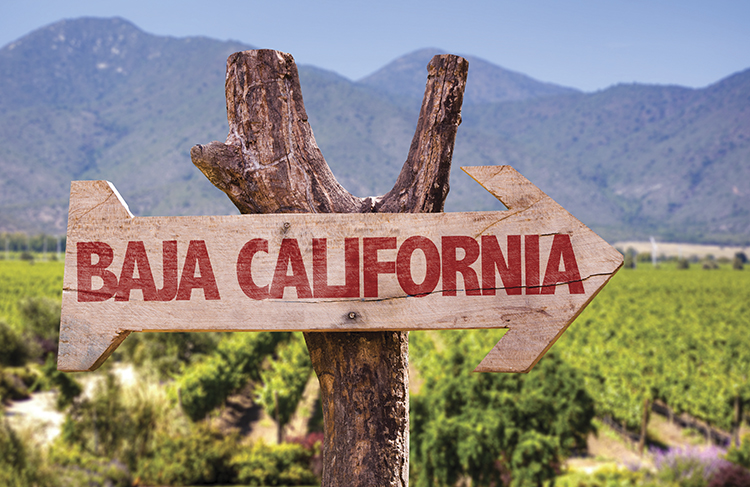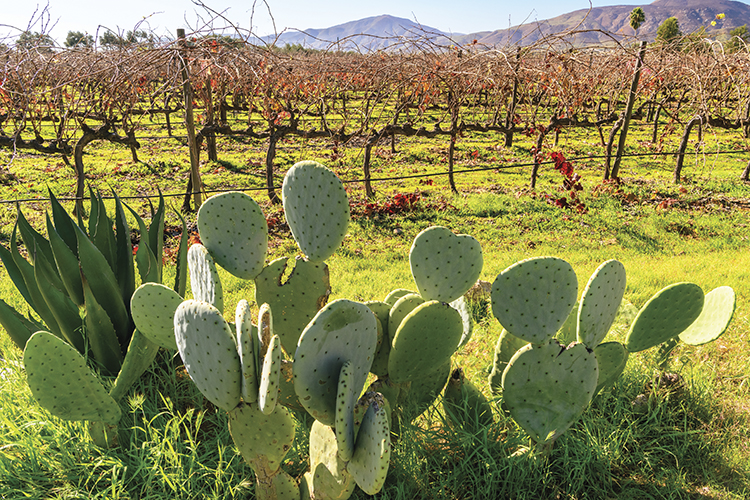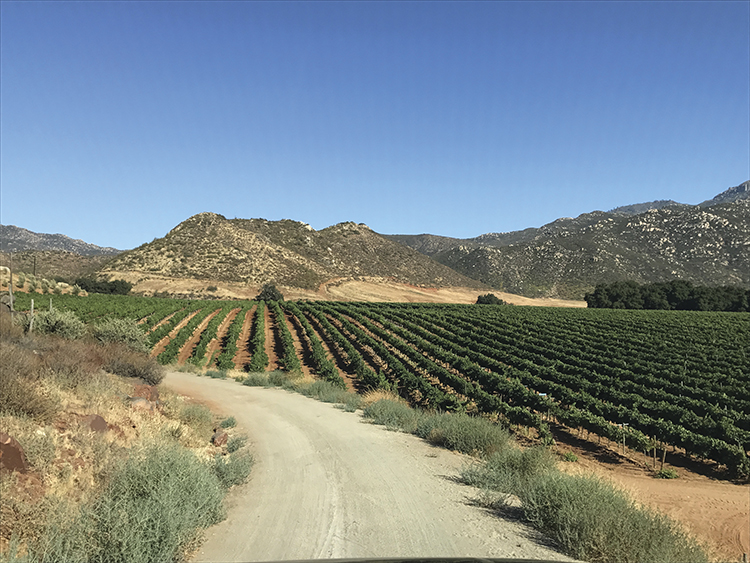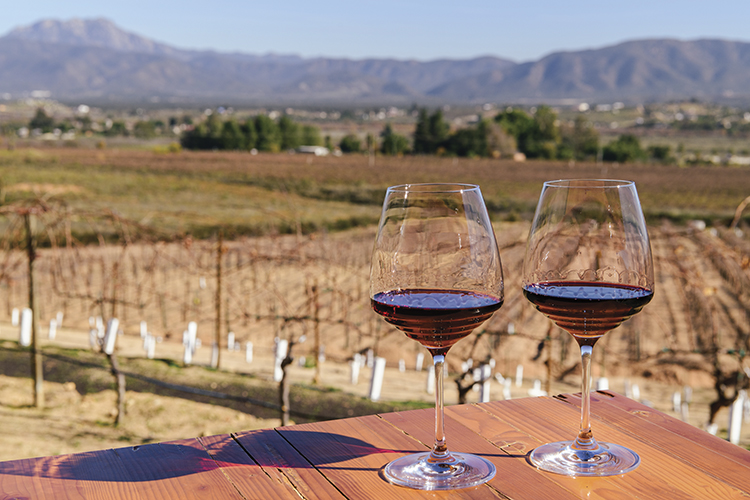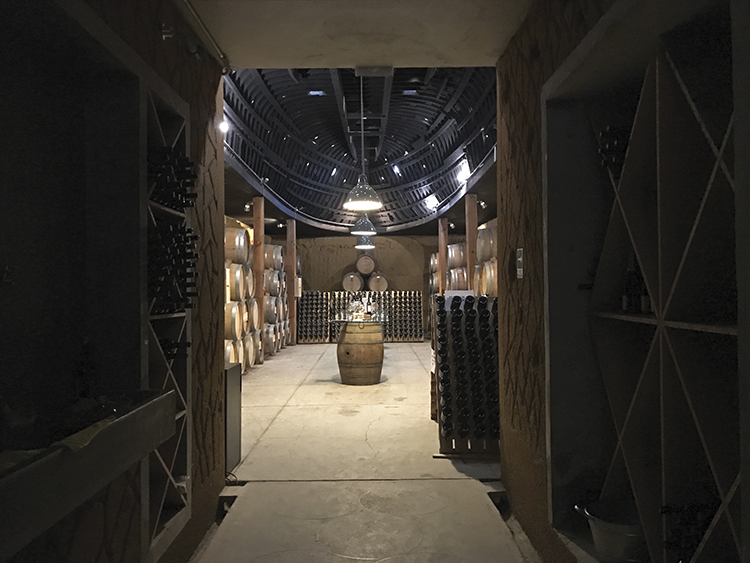To understand the Valle de Guadalupe, one of the most currently talked-about winegrowing regions, it’s important to know the lay of the land. Baja California is a narrow peninsula extending into the Pacific Ocean from Southern California.
The region is a territory of Mexico, just as all of California was, following Mexican Independence in 1821 until the Mexican War in 1846. After the war, California was taken as American land, but Baja California was given to Mexico via the Treaty of Guadalupe Hidalgo in 1848. So while the Mexican territory bares California in its name, Baja California is part of Mexico.
Because California and Baja California were once connected pieces of land controlled by one entity, the First Mexican Empire, Baja has continued to have a close relationship with tourism from California, given the easy border-crossing access via numerous entry points. That, along with Baja’s tourism popularity, and it’s no surprise that Baja has decidedly invested in its wine-tourism scene.
In the Valle de Guadalupe
The Valle de Guadalupe is located just outside the desirable vacation destination of Ensenada—with its idyllic beaches, coastal shopping, fresh seafood, and craft beer scene. As a port city and prime cultural hub of Mexico, Ensenada boasts a robust economy and attracts many tourists each year. It was only a matter of time before tourists started catching on to the wine scene just outside of the city in the Valle.
Wine grapes were planted in Mexico originally by the Spanish in the 16th century, so the country has a longstanding history of wine growing just as many other New World regions do. But it is only within the past decade or so that the area has received significant investment and interest from travelers. While many of the vines are young and newly planted as expansion has increased, there are also vineyards in the region that have been rooted for more than 50 years.
Terroir: The Magic is in the Sea
As a hot, subtropical climate, it may come as a surprise that the Valle de Guadalupe can even grow wine grapes successfully, but the magic is in the sea. Most of the vineyards in the Valle are located within 15 miles of the Pacific Ocean, offering a significant maritime influence. The close proximity to the sea drastically impacts the vineyards’ terroir, bringing the necessary cooling influence successful for grape growing.
“A lot of people claim that Valle wines taste salty,” said Joaquin Quintero, owner of Baja Winery Tours, a small tour-operating company that offers public and private tours of the Valle de Guadalupe winegrowing region. “This is because it’s an ancient seabed, so there is a high level of minerality in the soil profile, and that comes through in many of the wines,” he explained.
Because of the region’s subtropical climate, red grape varieties are most popular, and Quintero admitted, “the most ubiquitous right now is Nebbiolo… There’s a ton of Nebbiolo coming out of Valle and for good reason—it just loves to grow there.” As investment has come in and wineries have grown their vineyard acreage and trialed different varieties, Nebbiolo has risen to the top.
On the Rise
The vineyard expansion, construction of new winery buildings, and general explosion of the wine scene in recent years is palpable. “Fifteen years ago, there were maybe 20 wineries at the most,” admitted Quintero. Today, the region has roughly 100 wineries crafting wines from local grapes—whether they are estate grown or sourced from local growers. “A lot of people are now building winery tasting rooms or wine bars,” Quintero said, as many of the family-owned estates previously had no formal tasting locations.
Many wine enthusiasts may have caught the buzz of the Valle and are wondering: why has this region suddenly come to life? Local families and domestic and foreign investors have seen the potential of the Valle de Guadalupe. It’s in a prime location close to Ensenada—an already well-traveled destination—and the region has proven itself in terms of wine quality. “Over the years, the wines have really improved leaps and bounds,” said Quintero. Education, knowledge, and investment have allowed local winegrowers and winemakers to take advantage of the terroir and craft quality-driven wines. “There is a lot of investment coming in, and as Valle gets more popular, business owners are adapting… wineries have grown and have been honing their craft.”
While travelers to other famous winegrowing regions like Napa Valley know that investment can have its drawbacks, for the time being, the Valle de Guadalupe and travelers to the area are benefitting from it. There are more places to visit with tasting facilities, more tasting experiences and authentic culinary pairings, and overall, higher production of wines from which to choose and enjoy—and the quality is undoubtedly on the rise.
Wineries to Know
Santo Tomás: Santo Tomás is the oldest winery in the Valle de Guadalupe. They craft numerous varietals across three collections of wine—each with distinguishing price points. They make classics like Chardonnay and Cabernet Sauvignon, along with a selection of red blends and single varietals such as Tempranillo, Barbera, and Syrah. // www.santo-tomas.com
Cavas Sol y Barro: At Cavas Sol y Barro, a tiny family-owned estate, guests can expect warm hospitality and a welcoming, laid-back experience. Italian classics like Nebbiolo and Barbera are crafted as balanced red blends, and the unique Malvoisie is also a favorite. // www.facebook.com/solybarro/
Lomita: Lomita is unique in that it’s a gravity-flow winery, crafting wines without the use of machines to move the grapes and juice through fermentation and barreling. They produce a handful of whites, including Sauvignon Blanc, and a single varietal Grenache from 30- to 40-year-old vines, among others. // www.lomita.meitre.com
Finca La Carrodilla: For an upscale experience, Finca La Carrodilla is a must. Showing off the investment side of the Valle and boasting beautiful new structures, farm animals, vegetable gardens, and food and wine pairing experiences, this estate is all-encompassing. Chenin Blanc and Tempranillo are just a couple of the varietals produced here. // www.fincalacarrodilla.mx
Viña de Frannes: Established by Ernesto Alvarez Morphy Camou, this off the grid winery is known for its limited production Cabernet Sauvignon and for their rock star winemaker, Michel Rolland. The tasting room is one of the area’s finest, with minimalist architecture within a glass cube. // +52 646 688 1955
Vena Cava: A visit to Vena Cava is more than just a wine tasting experience. Visitors are as intrigued with the premises as they are with the wine. Designed by architect Alejandro D’Acosta, the building is made from nearly all reclaimed materials such as fishing boats, wood and recycled bottles and tires. The wines, mostly blends, are made by owner/winemaker Phil Gregory, and are reflective of his experimental style and local terroir. Don’t miss the celebrated food truck, “Troika,” named for its delicious tacos, tostadas, churros, and fresh oysters. // www.venacavawine.com

